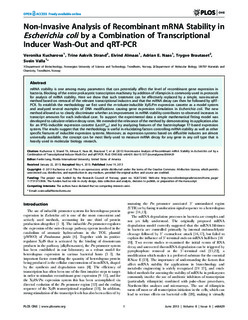| dc.contributor.author | Kucharova, Veronika | |
| dc.contributor.author | Aakvik, Trine | |
| dc.contributor.author | Almaas, Eivind | |
| dc.contributor.author | Naas, Adrian Ertsås | |
| dc.contributor.author | Brautaset, Trygve | |
| dc.contributor.author | Valla, Svein | |
| dc.date.accessioned | 2015-11-20T10:53:53Z | |
| dc.date.accessioned | 2019-04-04T08:42:11Z | |
| dc.date.available | 2015-11-20T10:53:53Z | |
| dc.date.available | 2019-04-04T08:42:11Z | |
| dc.date.issued | 2013 | |
| dc.identifier.citation | PLoS ONE 2013, 8(6) | nb_NO |
| dc.identifier.issn | 1932-6203 | |
| dc.identifier.uri | http://hdl.handle.net/11250/2593241 | |
| dc.description.abstract | mRNA stability is one among many parameters that can potentially affect the level of recombinant gene expression in bacteria. Blocking of the entire prokaryotic transcription machinery by addition of rifampicin is commonly used in protocols for analysis of mRNA stability. Here we show that such treatment can be effectively replaced by a simple, non-invasive method based on removal of the relevant transcriptional inducers and that the mRNA decay can then be followed by qRT-PCR. To establish the methodology we first used the m-toluate-inducible XylS/Pm expression cassette as a model system and analyzed several examples of DNA modifications causing gene expression stimulation in Escherichia coli. The new method allowed us to clearly discriminate whether an improvement in mRNA stability contributes to observed increases in transcript amounts for each individual case. To support the experimental data a simple mathematical fitting model was developed to calculate relative decay rates. We extended the relevance of the method by demonstrating its application also for an IPTG-inducible expression cassette (LacI/Ptac) and by analyzing features of the bacteriophage T7-based expression system. The results suggest that the methodology is useful in elucidating factors controlling mRNA stability as well as other specific features of inducible expression systems. Moreover, as expression systems based on diffusible inducers are almost universally available, the concept can be most likely used to measure mRNA decay for any gene in any cell type that is heavily used in molecular biology research. | nb_NO |
| dc.language.iso | eng | nb_NO |
| dc.rights | Navngivelse 4.0 Internasjonal | * |
| dc.rights.uri | http://creativecommons.org/licenses/by/4.0/deed.no | * |
| dc.title | Non-Invasive Analysis of Recombinant mRNA Stability in Escherichia coli by a Combination of Transcriptional Inducer Wash-Out and qRT-PCR | nb_NO |
| dc.type | Journal article | nb_NO |
| dc.type | Peer reviewed | nb_NO |
| dc.date.updated | 2015-11-20T10:53:53Z | |
| dc.description.version | publishedVersion | nb_NO |
| dc.rights.holder | © The Authors. This is an open-access article distributed under the terms of the Creative Commons Attribution License, which permits unrestricted use, distribution, and reproduction in any medium, provided the original author and source are credited. | nb_NO |
| dc.identifier.doi | 10.1371/journal.pone.0066429 | |
| dc.identifier.cristin | 1058647 | |
| dc.relation.project | Norges forskningsråd 182672 | nb_NO |

